Literature Review: Bakery Business, New Product and Market Analysis
VerifiedAdded on 2023/03/17
|11
|3425
|90
Report
AI Summary
This literature review explores the bakery business, focusing on introducing a new product. It begins with an introduction to bakery products, their history, and significance in society, highlighting the industry's growth and market trends. The project objectives are to understand the bakery business through literature and introduce a new product. The scope involves using the literature to create an effective business proposal. The review covers the concept of bakery products, their categorization, and the increasing demand, especially among the younger generation. It also discusses the history of the bakery business, its importance, and the types of bakeries, ranging from small craftsman businesses to industrial operations. The review also touches upon pricing considerations and consumer behavior in the bakery business, including competition and the need for continuous improvement. Various sources are cited to support the findings, providing a comprehensive overview of the bakery industry.

Running Head: LITERATURE REVIEW
ASSESSMENT 1- LITERATURE REVIEW
ASSESSMENT 1- LITERATURE REVIEW
Paraphrase This Document
Need a fresh take? Get an instant paraphrase of this document with our AI Paraphraser
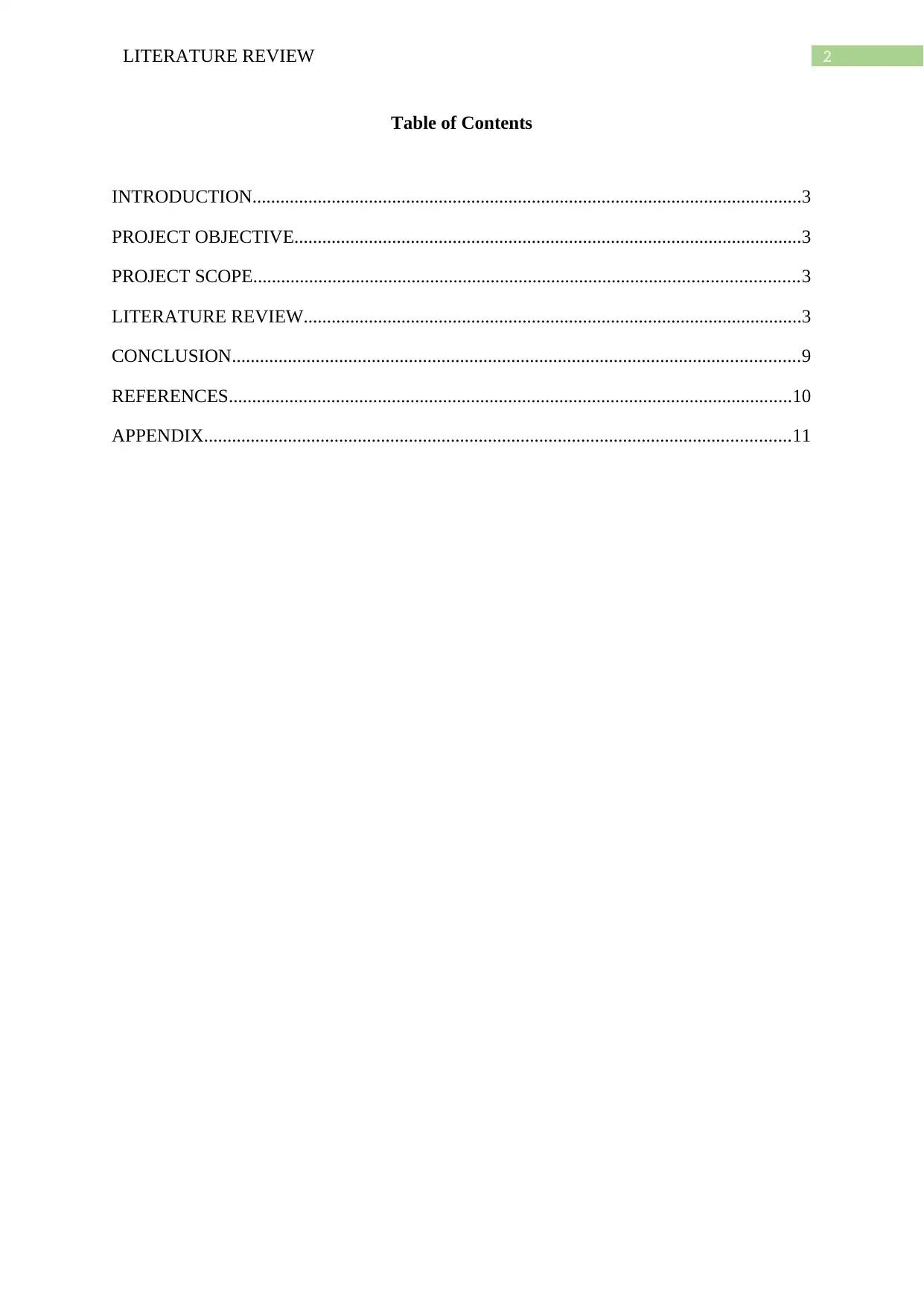
2LITERATURE REVIEW
Table of Contents
INTRODUCTION......................................................................................................................3
PROJECT OBJECTIVE.............................................................................................................3
PROJECT SCOPE.....................................................................................................................3
LITERATURE REVIEW...........................................................................................................3
CONCLUSION..........................................................................................................................9
REFERENCES.........................................................................................................................10
APPENDIX..............................................................................................................................11
Table of Contents
INTRODUCTION......................................................................................................................3
PROJECT OBJECTIVE.............................................................................................................3
PROJECT SCOPE.....................................................................................................................3
LITERATURE REVIEW...........................................................................................................3
CONCLUSION..........................................................................................................................9
REFERENCES.........................................................................................................................10
APPENDIX..............................................................................................................................11
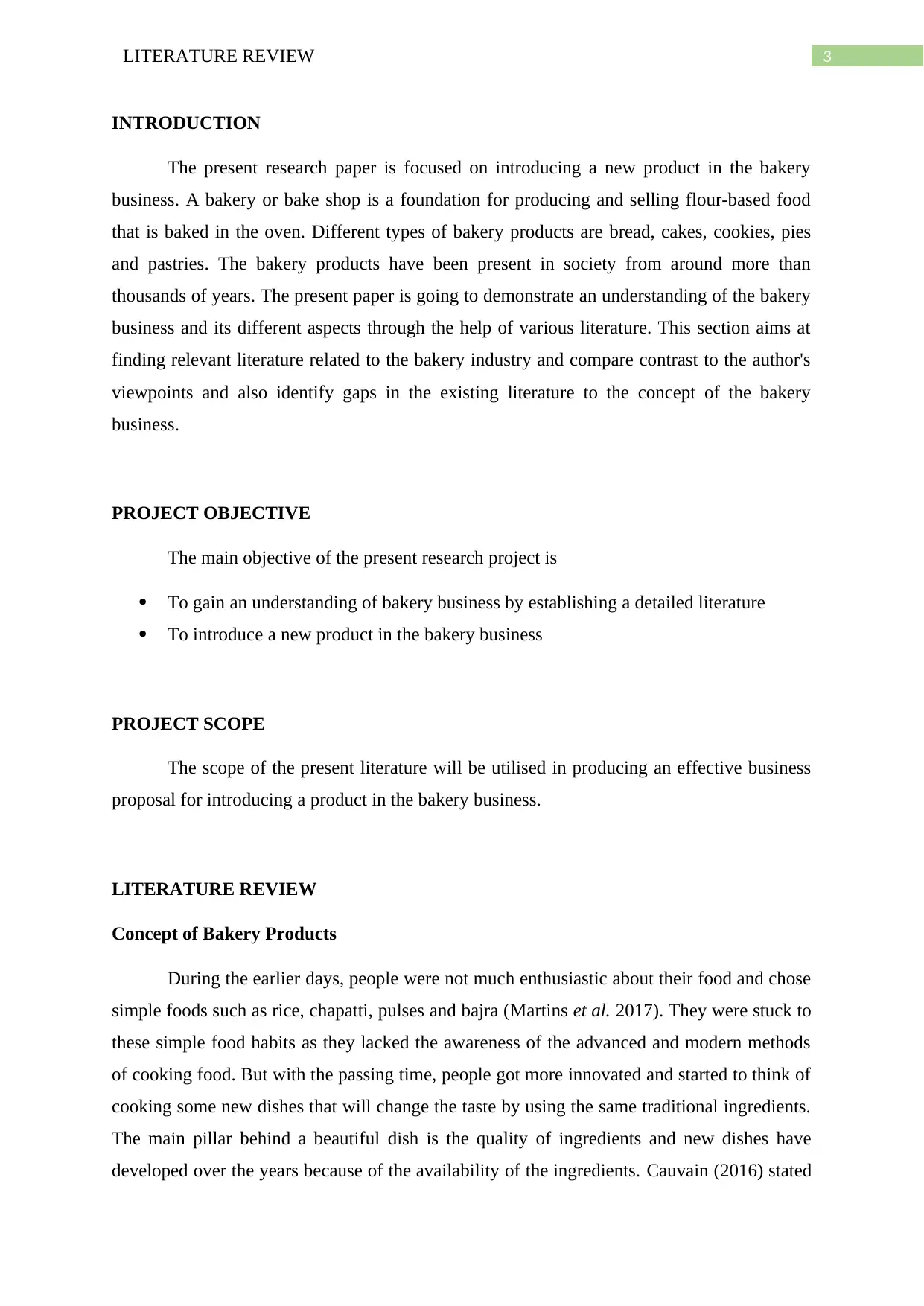
3LITERATURE REVIEW
INTRODUCTION
The present research paper is focused on introducing a new product in the bakery
business. A bakery or bake shop is a foundation for producing and selling flour-based food
that is baked in the oven. Different types of bakery products are bread, cakes, cookies, pies
and pastries. The bakery products have been present in society from around more than
thousands of years. The present paper is going to demonstrate an understanding of the bakery
business and its different aspects through the help of various literature. This section aims at
finding relevant literature related to the bakery industry and compare contrast to the author's
viewpoints and also identify gaps in the existing literature to the concept of the bakery
business.
PROJECT OBJECTIVE
The main objective of the present research project is
To gain an understanding of bakery business by establishing a detailed literature
To introduce a new product in the bakery business
PROJECT SCOPE
The scope of the present literature will be utilised in producing an effective business
proposal for introducing a product in the bakery business.
LITERATURE REVIEW
Concept of Bakery Products
During the earlier days, people were not much enthusiastic about their food and chose
simple foods such as rice, chapatti, pulses and bajra (Martins et al. 2017). They were stuck to
these simple food habits as they lacked the awareness of the advanced and modern methods
of cooking food. But with the passing time, people got more innovated and started to think of
cooking some new dishes that will change the taste by using the same traditional ingredients.
The main pillar behind a beautiful dish is the quality of ingredients and new dishes have
developed over the years because of the availability of the ingredients. Cauvain (2016) stated
INTRODUCTION
The present research paper is focused on introducing a new product in the bakery
business. A bakery or bake shop is a foundation for producing and selling flour-based food
that is baked in the oven. Different types of bakery products are bread, cakes, cookies, pies
and pastries. The bakery products have been present in society from around more than
thousands of years. The present paper is going to demonstrate an understanding of the bakery
business and its different aspects through the help of various literature. This section aims at
finding relevant literature related to the bakery industry and compare contrast to the author's
viewpoints and also identify gaps in the existing literature to the concept of the bakery
business.
PROJECT OBJECTIVE
The main objective of the present research project is
To gain an understanding of bakery business by establishing a detailed literature
To introduce a new product in the bakery business
PROJECT SCOPE
The scope of the present literature will be utilised in producing an effective business
proposal for introducing a product in the bakery business.
LITERATURE REVIEW
Concept of Bakery Products
During the earlier days, people were not much enthusiastic about their food and chose
simple foods such as rice, chapatti, pulses and bajra (Martins et al. 2017). They were stuck to
these simple food habits as they lacked the awareness of the advanced and modern methods
of cooking food. But with the passing time, people got more innovated and started to think of
cooking some new dishes that will change the taste by using the same traditional ingredients.
The main pillar behind a beautiful dish is the quality of ingredients and new dishes have
developed over the years because of the availability of the ingredients. Cauvain (2016) stated
⊘ This is a preview!⊘
Do you want full access?
Subscribe today to unlock all pages.

Trusted by 1+ million students worldwide
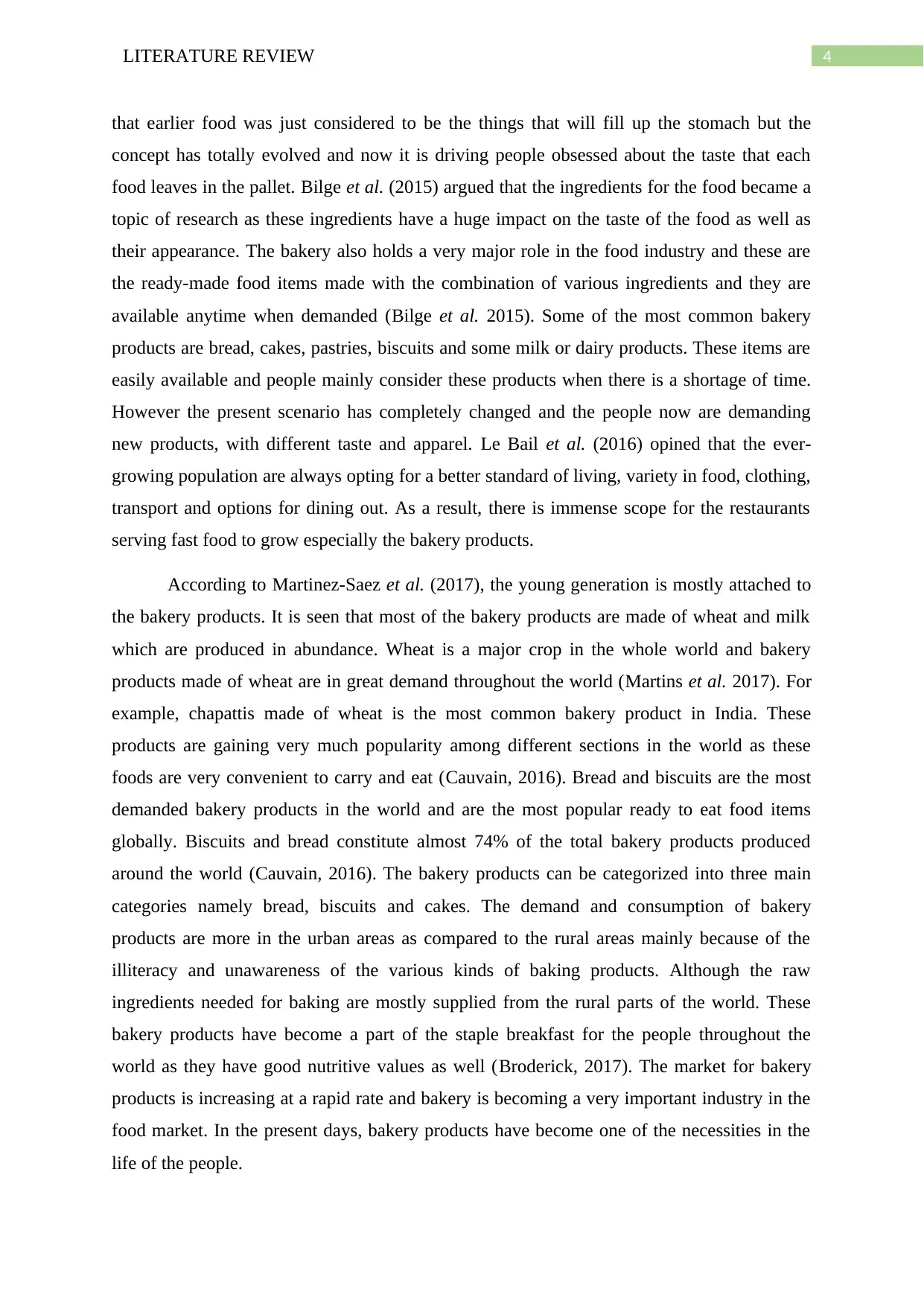
4LITERATURE REVIEW
that earlier food was just considered to be the things that will fill up the stomach but the
concept has totally evolved and now it is driving people obsessed about the taste that each
food leaves in the pallet. Bilge et al. (2015) argued that the ingredients for the food became a
topic of research as these ingredients have a huge impact on the taste of the food as well as
their appearance. The bakery also holds a very major role in the food industry and these are
the ready-made food items made with the combination of various ingredients and they are
available anytime when demanded (Bilge et al. 2015). Some of the most common bakery
products are bread, cakes, pastries, biscuits and some milk or dairy products. These items are
easily available and people mainly consider these products when there is a shortage of time.
However the present scenario has completely changed and the people now are demanding
new products, with different taste and apparel. Le Bail et al. (2016) opined that the ever-
growing population are always opting for a better standard of living, variety in food, clothing,
transport and options for dining out. As a result, there is immense scope for the restaurants
serving fast food to grow especially the bakery products.
According to Martinez-Saez et al. (2017), the young generation is mostly attached to
the bakery products. It is seen that most of the bakery products are made of wheat and milk
which are produced in abundance. Wheat is a major crop in the whole world and bakery
products made of wheat are in great demand throughout the world (Martins et al. 2017). For
example, chapattis made of wheat is the most common bakery product in India. These
products are gaining very much popularity among different sections in the world as these
foods are very convenient to carry and eat (Cauvain, 2016). Bread and biscuits are the most
demanded bakery products in the world and are the most popular ready to eat food items
globally. Biscuits and bread constitute almost 74% of the total bakery products produced
around the world (Cauvain, 2016). The bakery products can be categorized into three main
categories namely bread, biscuits and cakes. The demand and consumption of bakery
products are more in the urban areas as compared to the rural areas mainly because of the
illiteracy and unawareness of the various kinds of baking products. Although the raw
ingredients needed for baking are mostly supplied from the rural parts of the world. These
bakery products have become a part of the staple breakfast for the people throughout the
world as they have good nutritive values as well (Broderick, 2017). The market for bakery
products is increasing at a rapid rate and bakery is becoming a very important industry in the
food market. In the present days, bakery products have become one of the necessities in the
life of the people.
that earlier food was just considered to be the things that will fill up the stomach but the
concept has totally evolved and now it is driving people obsessed about the taste that each
food leaves in the pallet. Bilge et al. (2015) argued that the ingredients for the food became a
topic of research as these ingredients have a huge impact on the taste of the food as well as
their appearance. The bakery also holds a very major role in the food industry and these are
the ready-made food items made with the combination of various ingredients and they are
available anytime when demanded (Bilge et al. 2015). Some of the most common bakery
products are bread, cakes, pastries, biscuits and some milk or dairy products. These items are
easily available and people mainly consider these products when there is a shortage of time.
However the present scenario has completely changed and the people now are demanding
new products, with different taste and apparel. Le Bail et al. (2016) opined that the ever-
growing population are always opting for a better standard of living, variety in food, clothing,
transport and options for dining out. As a result, there is immense scope for the restaurants
serving fast food to grow especially the bakery products.
According to Martinez-Saez et al. (2017), the young generation is mostly attached to
the bakery products. It is seen that most of the bakery products are made of wheat and milk
which are produced in abundance. Wheat is a major crop in the whole world and bakery
products made of wheat are in great demand throughout the world (Martins et al. 2017). For
example, chapattis made of wheat is the most common bakery product in India. These
products are gaining very much popularity among different sections in the world as these
foods are very convenient to carry and eat (Cauvain, 2016). Bread and biscuits are the most
demanded bakery products in the world and are the most popular ready to eat food items
globally. Biscuits and bread constitute almost 74% of the total bakery products produced
around the world (Cauvain, 2016). The bakery products can be categorized into three main
categories namely bread, biscuits and cakes. The demand and consumption of bakery
products are more in the urban areas as compared to the rural areas mainly because of the
illiteracy and unawareness of the various kinds of baking products. Although the raw
ingredients needed for baking are mostly supplied from the rural parts of the world. These
bakery products have become a part of the staple breakfast for the people throughout the
world as they have good nutritive values as well (Broderick, 2017). The market for bakery
products is increasing at a rapid rate and bakery is becoming a very important industry in the
food market. In the present days, bakery products have become one of the necessities in the
life of the people.
Paraphrase This Document
Need a fresh take? Get an instant paraphrase of this document with our AI Paraphraser
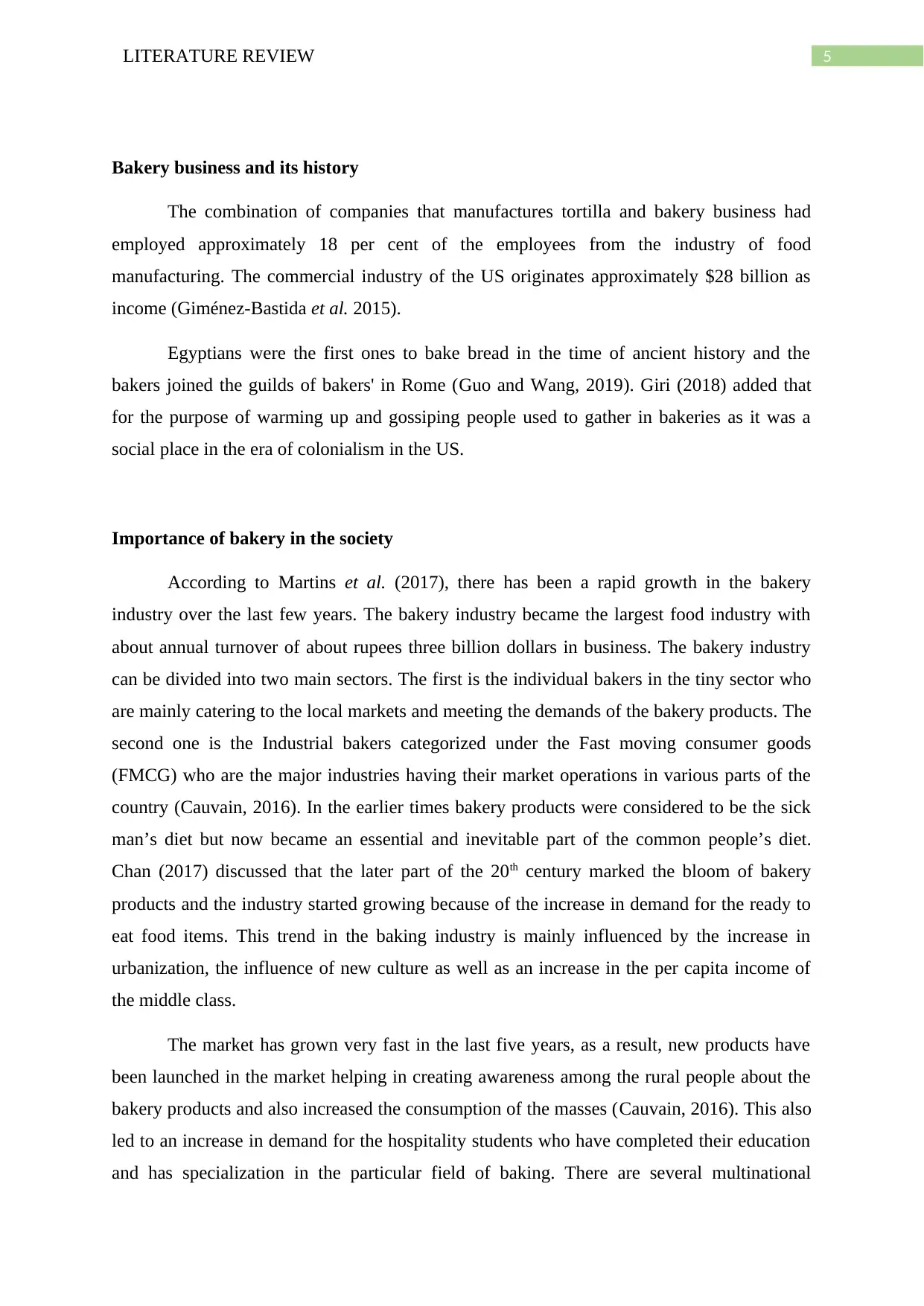
5LITERATURE REVIEW
Bakery business and its history
The combination of companies that manufactures tortilla and bakery business had
employed approximately 18 per cent of the employees from the industry of food
manufacturing. The commercial industry of the US originates approximately $28 billion as
income (Giménez-Bastida et al. 2015).
Egyptians were the first ones to bake bread in the time of ancient history and the
bakers joined the guilds of bakers' in Rome (Guo and Wang, 2019). Giri (2018) added that
for the purpose of warming up and gossiping people used to gather in bakeries as it was a
social place in the era of colonialism in the US.
Importance of bakery in the society
According to Martins et al. (2017), there has been a rapid growth in the bakery
industry over the last few years. The bakery industry became the largest food industry with
about annual turnover of about rupees three billion dollars in business. The bakery industry
can be divided into two main sectors. The first is the individual bakers in the tiny sector who
are mainly catering to the local markets and meeting the demands of the bakery products. The
second one is the Industrial bakers categorized under the Fast moving consumer goods
(FMCG) who are the major industries having their market operations in various parts of the
country (Cauvain, 2016). In the earlier times bakery products were considered to be the sick
man’s diet but now became an essential and inevitable part of the common people’s diet.
Chan (2017) discussed that the later part of the 20th century marked the bloom of bakery
products and the industry started growing because of the increase in demand for the ready to
eat food items. This trend in the baking industry is mainly influenced by the increase in
urbanization, the influence of new culture as well as an increase in the per capita income of
the middle class.
The market has grown very fast in the last five years, as a result, new products have
been launched in the market helping in creating awareness among the rural people about the
bakery products and also increased the consumption of the masses (Cauvain, 2016). This also
led to an increase in demand for the hospitality students who have completed their education
and has specialization in the particular field of baking. There are several multinational
Bakery business and its history
The combination of companies that manufactures tortilla and bakery business had
employed approximately 18 per cent of the employees from the industry of food
manufacturing. The commercial industry of the US originates approximately $28 billion as
income (Giménez-Bastida et al. 2015).
Egyptians were the first ones to bake bread in the time of ancient history and the
bakers joined the guilds of bakers' in Rome (Guo and Wang, 2019). Giri (2018) added that
for the purpose of warming up and gossiping people used to gather in bakeries as it was a
social place in the era of colonialism in the US.
Importance of bakery in the society
According to Martins et al. (2017), there has been a rapid growth in the bakery
industry over the last few years. The bakery industry became the largest food industry with
about annual turnover of about rupees three billion dollars in business. The bakery industry
can be divided into two main sectors. The first is the individual bakers in the tiny sector who
are mainly catering to the local markets and meeting the demands of the bakery products. The
second one is the Industrial bakers categorized under the Fast moving consumer goods
(FMCG) who are the major industries having their market operations in various parts of the
country (Cauvain, 2016). In the earlier times bakery products were considered to be the sick
man’s diet but now became an essential and inevitable part of the common people’s diet.
Chan (2017) discussed that the later part of the 20th century marked the bloom of bakery
products and the industry started growing because of the increase in demand for the ready to
eat food items. This trend in the baking industry is mainly influenced by the increase in
urbanization, the influence of new culture as well as an increase in the per capita income of
the middle class.
The market has grown very fast in the last five years, as a result, new products have
been launched in the market helping in creating awareness among the rural people about the
bakery products and also increased the consumption of the masses (Cauvain, 2016). This also
led to an increase in demand for the hospitality students who have completed their education
and has specialization in the particular field of baking. There are several multinational

6LITERATURE REVIEW
organizations such as the manufacturer of the raw materials, malls in the shopping
complexes, equipment developer and several bakery brands are growing in several countries
providing various job roles and offer good salaries. Bilge et al. (2015) also added that the
growing market has led to the standardization of the society and also helped to improve the
living standard of the people. The baking industry has offered a variety of job roles for the
people especially for the bakers, cake decorators, trainers, process managers and many others
related to this field of food production (Broderick, 2017). The increase in the demand for
bakery products has helped to increase job opportunities for the people especially for the
younger generation (Le Bail et al. 2016). Trained professionals in the field of the bakery are
getting high paid jobs around the globe. The quality of the bakery products have earned its
name around the world and also increased the exportation of these products, as a result, it
helped in uplifting the economy of the many nations by earning foreign currencies.
The increased production in the bakery has helped in giving relief to the women in the
daily kitchen. Giri et al. (2018) argued women are now not just housewives but also working,
as a result, they get to spend very little time in their homes. Readymade bakery products have
eased the process of cooking for the women in the kitchens. Moreover, Martins et al. (2017)
also mentioned that bakery products do not get spoilt easily and can be stored for a few days
these people naturally are tending toward bakery products. The best part of these products is
that unlike other food items they retain their taste after a few days. The increase in the bakery
industry has also helped the basic industry that is agriculture to flourish as the demands for
wheat and milk is ever increasing (Martinez-Saez et al. 2017). Due to bakery agriculture
became commercialized and now farmers have the opportunity to sell their wheat at five
different prices in the local as well as the international market. Similarly dairy is also a very
important aspect of bakery and India being one of the greatest producers of milk naturally
leads in the dairy items. Giri (2018) opined there are various shortening agents required for
baking which are easily available in the global market. Since the consumption of bakery
products is increasing each day the demands are also getting higher. It will be beneficial for
the entrepreneurs to invest in the sector that is going to flourish even more in the coming
years.
Types of Bakery
organizations such as the manufacturer of the raw materials, malls in the shopping
complexes, equipment developer and several bakery brands are growing in several countries
providing various job roles and offer good salaries. Bilge et al. (2015) also added that the
growing market has led to the standardization of the society and also helped to improve the
living standard of the people. The baking industry has offered a variety of job roles for the
people especially for the bakers, cake decorators, trainers, process managers and many others
related to this field of food production (Broderick, 2017). The increase in the demand for
bakery products has helped to increase job opportunities for the people especially for the
younger generation (Le Bail et al. 2016). Trained professionals in the field of the bakery are
getting high paid jobs around the globe. The quality of the bakery products have earned its
name around the world and also increased the exportation of these products, as a result, it
helped in uplifting the economy of the many nations by earning foreign currencies.
The increased production in the bakery has helped in giving relief to the women in the
daily kitchen. Giri et al. (2018) argued women are now not just housewives but also working,
as a result, they get to spend very little time in their homes. Readymade bakery products have
eased the process of cooking for the women in the kitchens. Moreover, Martins et al. (2017)
also mentioned that bakery products do not get spoilt easily and can be stored for a few days
these people naturally are tending toward bakery products. The best part of these products is
that unlike other food items they retain their taste after a few days. The increase in the bakery
industry has also helped the basic industry that is agriculture to flourish as the demands for
wheat and milk is ever increasing (Martinez-Saez et al. 2017). Due to bakery agriculture
became commercialized and now farmers have the opportunity to sell their wheat at five
different prices in the local as well as the international market. Similarly dairy is also a very
important aspect of bakery and India being one of the greatest producers of milk naturally
leads in the dairy items. Giri (2018) opined there are various shortening agents required for
baking which are easily available in the global market. Since the consumption of bakery
products is increasing each day the demands are also getting higher. It will be beneficial for
the entrepreneurs to invest in the sector that is going to flourish even more in the coming
years.
Types of Bakery
⊘ This is a preview!⊘
Do you want full access?
Subscribe today to unlock all pages.

Trusted by 1+ million students worldwide
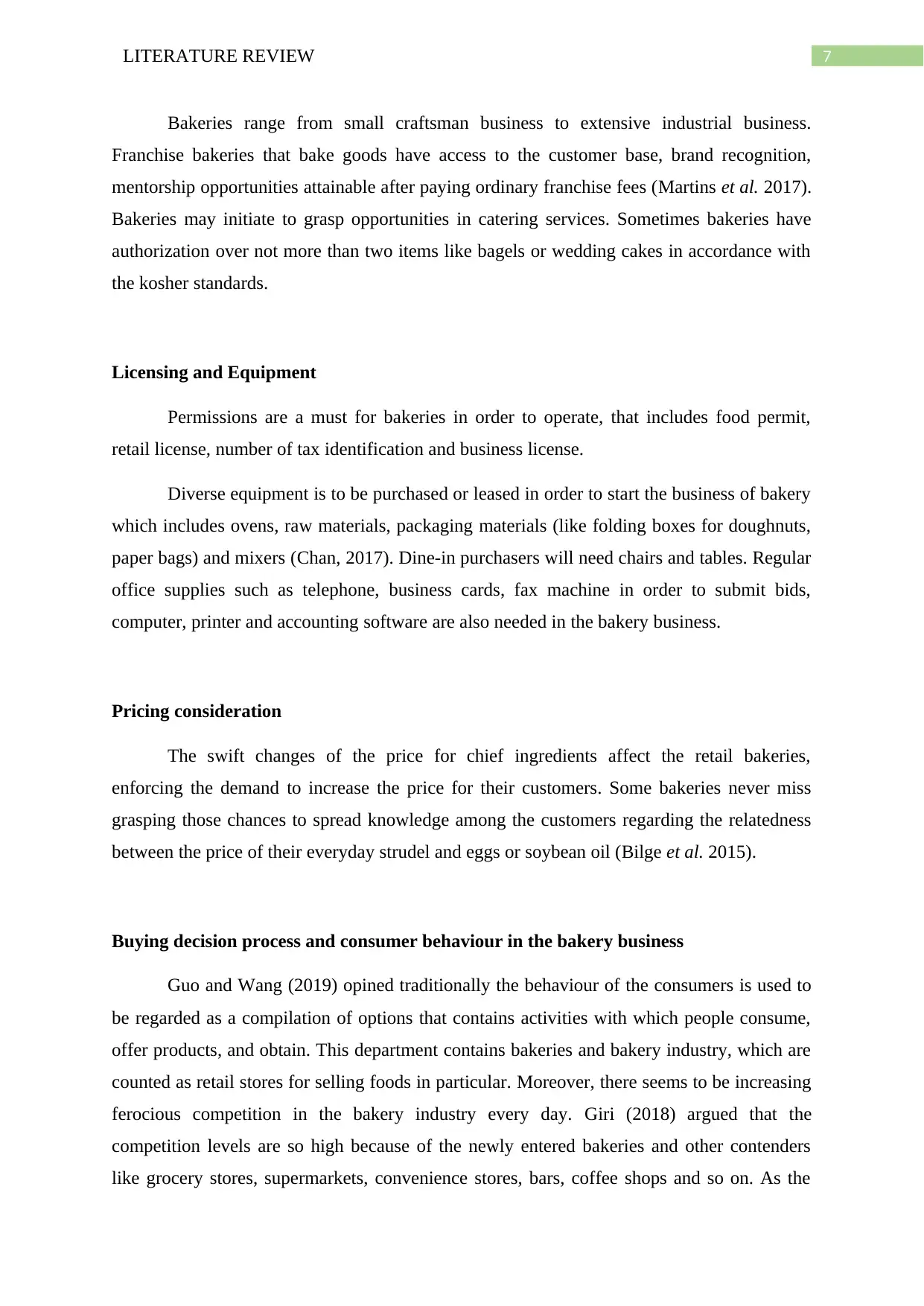
7LITERATURE REVIEW
Bakeries range from small craftsman business to extensive industrial business.
Franchise bakeries that bake goods have access to the customer base, brand recognition,
mentorship opportunities attainable after paying ordinary franchise fees (Martins et al. 2017).
Bakeries may initiate to grasp opportunities in catering services. Sometimes bakeries have
authorization over not more than two items like bagels or wedding cakes in accordance with
the kosher standards.
Licensing and Equipment
Permissions are a must for bakeries in order to operate, that includes food permit,
retail license, number of tax identification and business license.
Diverse equipment is to be purchased or leased in order to start the business of bakery
which includes ovens, raw materials, packaging materials (like folding boxes for doughnuts,
paper bags) and mixers (Chan, 2017). Dine-in purchasers will need chairs and tables. Regular
office supplies such as telephone, business cards, fax machine in order to submit bids,
computer, printer and accounting software are also needed in the bakery business.
Pricing consideration
The swift changes of the price for chief ingredients affect the retail bakeries,
enforcing the demand to increase the price for their customers. Some bakeries never miss
grasping those chances to spread knowledge among the customers regarding the relatedness
between the price of their everyday strudel and eggs or soybean oil (Bilge et al. 2015).
Buying decision process and consumer behaviour in the bakery business
Guo and Wang (2019) opined traditionally the behaviour of the consumers is used to
be regarded as a compilation of options that contains activities with which people consume,
offer products, and obtain. This department contains bakeries and bakery industry, which are
counted as retail stores for selling foods in particular. Moreover, there seems to be increasing
ferocious competition in the bakery industry every day. Giri (2018) argued that the
competition levels are so high because of the newly entered bakeries and other contenders
like grocery stores, supermarkets, convenience stores, bars, coffee shops and so on. As the
Bakeries range from small craftsman business to extensive industrial business.
Franchise bakeries that bake goods have access to the customer base, brand recognition,
mentorship opportunities attainable after paying ordinary franchise fees (Martins et al. 2017).
Bakeries may initiate to grasp opportunities in catering services. Sometimes bakeries have
authorization over not more than two items like bagels or wedding cakes in accordance with
the kosher standards.
Licensing and Equipment
Permissions are a must for bakeries in order to operate, that includes food permit,
retail license, number of tax identification and business license.
Diverse equipment is to be purchased or leased in order to start the business of bakery
which includes ovens, raw materials, packaging materials (like folding boxes for doughnuts,
paper bags) and mixers (Chan, 2017). Dine-in purchasers will need chairs and tables. Regular
office supplies such as telephone, business cards, fax machine in order to submit bids,
computer, printer and accounting software are also needed in the bakery business.
Pricing consideration
The swift changes of the price for chief ingredients affect the retail bakeries,
enforcing the demand to increase the price for their customers. Some bakeries never miss
grasping those chances to spread knowledge among the customers regarding the relatedness
between the price of their everyday strudel and eggs or soybean oil (Bilge et al. 2015).
Buying decision process and consumer behaviour in the bakery business
Guo and Wang (2019) opined traditionally the behaviour of the consumers is used to
be regarded as a compilation of options that contains activities with which people consume,
offer products, and obtain. This department contains bakeries and bakery industry, which are
counted as retail stores for selling foods in particular. Moreover, there seems to be increasing
ferocious competition in the bakery industry every day. Giri (2018) argued that the
competition levels are so high because of the newly entered bakeries and other contenders
like grocery stores, supermarkets, convenience stores, bars, coffee shops and so on. As the
Paraphrase This Document
Need a fresh take? Get an instant paraphrase of this document with our AI Paraphraser

8LITERATURE REVIEW
demands of consumers of the food are becoming more vivid, bakeries are provoked to lead
towards uninterrupted improvement methods.
There is a progressed model proposed by Chan (2017) which shows that the process
of taking the decision of purchasing contains some stages: 1) acknowledging the requirement,
2) searching for information, 3) assessment of the pre-purchase options, 4) purchase, 5)
consumption, 6) assessment of disposal and post-consumer stages. Research papers stated
about the purchasing decision methods in bakeries which accepted this model, and in
addition, they also concluded that consumers are more likely to go through these sequences,
although environmental factors (social class, culture, reference group and so on) also affect
them. The existence of pivotal roles performed by the individuals while taking the decision of
purchasing is also noticeable (Broderick, 2017). In the similar sense, it is highlighted that any
person could be regarded as the initiator if that person points out to buy a service or product
and gathers all the information which would assist in the process of decision making. That
person is the influencer whose point of view has an effective impact on the process of
decision making. The decision maker is the one who determines and decides where, how and
what to purchase. The individual who consumes and uses the service and product is
undoubtedly the user and the buyer is the one who purchases. From the discussion of Cauvain
(2016) it is found that when the person realizes the distinction between the current conditions
of things versus what the person idealizes to be, it is namely the very first stage of the
decision-making process. It is stated that from external or internal stimuli the cognizance of
the want may arrive. The consciousness of the uneasiness of physical and psychological
nature helps the internal incentive to start (Le Bail et al. 2016). External agents are to be
blamed for unveiling some requirements which were not perceived earlier, that makes the
external stimuli impulses. Market actors like influential groups or advertising, advertisement
and individuals like family members, neighbours are the usual cause behind the external
stimuli.
Bilge et al. (2015) stated for the goods that are baked consisting organic and
conventional ingredients, they have shown the impact of the media, social groups and public
opinion in the purchasing process and the client's compliance to pay. The value of those
stimuli is well described as they are important in triggering all those stages for the buying
decision process. Searching for information is the second stage, where the user performs a
search among his memory (internal search) and the generators of information which are
external (Cauvain, 2016). When the consumers claim the information on prior knowledge of
demands of consumers of the food are becoming more vivid, bakeries are provoked to lead
towards uninterrupted improvement methods.
There is a progressed model proposed by Chan (2017) which shows that the process
of taking the decision of purchasing contains some stages: 1) acknowledging the requirement,
2) searching for information, 3) assessment of the pre-purchase options, 4) purchase, 5)
consumption, 6) assessment of disposal and post-consumer stages. Research papers stated
about the purchasing decision methods in bakeries which accepted this model, and in
addition, they also concluded that consumers are more likely to go through these sequences,
although environmental factors (social class, culture, reference group and so on) also affect
them. The existence of pivotal roles performed by the individuals while taking the decision of
purchasing is also noticeable (Broderick, 2017). In the similar sense, it is highlighted that any
person could be regarded as the initiator if that person points out to buy a service or product
and gathers all the information which would assist in the process of decision making. That
person is the influencer whose point of view has an effective impact on the process of
decision making. The decision maker is the one who determines and decides where, how and
what to purchase. The individual who consumes and uses the service and product is
undoubtedly the user and the buyer is the one who purchases. From the discussion of Cauvain
(2016) it is found that when the person realizes the distinction between the current conditions
of things versus what the person idealizes to be, it is namely the very first stage of the
decision-making process. It is stated that from external or internal stimuli the cognizance of
the want may arrive. The consciousness of the uneasiness of physical and psychological
nature helps the internal incentive to start (Le Bail et al. 2016). External agents are to be
blamed for unveiling some requirements which were not perceived earlier, that makes the
external stimuli impulses. Market actors like influential groups or advertising, advertisement
and individuals like family members, neighbours are the usual cause behind the external
stimuli.
Bilge et al. (2015) stated for the goods that are baked consisting organic and
conventional ingredients, they have shown the impact of the media, social groups and public
opinion in the purchasing process and the client's compliance to pay. The value of those
stimuli is well described as they are important in triggering all those stages for the buying
decision process. Searching for information is the second stage, where the user performs a
search among his memory (internal search) and the generators of information which are
external (Cauvain, 2016). When the consumers claim the information on prior knowledge of

9LITERATURE REVIEW
them about services, products, brands or companies attained over time then the internal
search takes its place, which also includes the purchasing and consumption earlier
experience. The found information from diverse sources like television, radio, magazines,
newspapers, billboards, internet and etc. while searching, shapes up the external search
(Martins et al. 2017). The sources which shape up the external search may also contain co-
workers, friends, relatives and other sources that are able to influence the decision of the
consumer. Broderick (2017) mentioned that researchers are usually attracted to the third stage
of the purchasing decision process. It has been stated that past experience and value shapes
the selection of the consumers. Hence, assessments acquired from the new reviews or
memory based on the information attained by external or internal search assists in the
consumer's selection process. About the strategy of competition at the market of baked goods,
the importance of what the consumers are thinking about a product, such as about its quality,
provided service and price, is highlighted. Also, Cauvain (2016) added in current times,
consumers are using images and mental associations to affect the selection process of
products.
CONCLUSION
The present section of literature has highlighted various aspects of bakery business
which would be utilised in successfully producing a business research proposal to introduce a
new product within the bakery business. The literature has reviewed the concept of bakery
products, bakery business and its history, types of the bakery, licensing and equipment within
the bakery business along with pricing consideration. Further, the paper also discussed the
buying decision process and consumer behaviour in the bakery business and the importance
of bakery in society.
them about services, products, brands or companies attained over time then the internal
search takes its place, which also includes the purchasing and consumption earlier
experience. The found information from diverse sources like television, radio, magazines,
newspapers, billboards, internet and etc. while searching, shapes up the external search
(Martins et al. 2017). The sources which shape up the external search may also contain co-
workers, friends, relatives and other sources that are able to influence the decision of the
consumer. Broderick (2017) mentioned that researchers are usually attracted to the third stage
of the purchasing decision process. It has been stated that past experience and value shapes
the selection of the consumers. Hence, assessments acquired from the new reviews or
memory based on the information attained by external or internal search assists in the
consumer's selection process. About the strategy of competition at the market of baked goods,
the importance of what the consumers are thinking about a product, such as about its quality,
provided service and price, is highlighted. Also, Cauvain (2016) added in current times,
consumers are using images and mental associations to affect the selection process of
products.
CONCLUSION
The present section of literature has highlighted various aspects of bakery business
which would be utilised in successfully producing a business research proposal to introduce a
new product within the bakery business. The literature has reviewed the concept of bakery
products, bakery business and its history, types of the bakery, licensing and equipment within
the bakery business along with pricing consideration. Further, the paper also discussed the
buying decision process and consumer behaviour in the bakery business and the importance
of bakery in society.
⊘ This is a preview!⊘
Do you want full access?
Subscribe today to unlock all pages.

Trusted by 1+ million students worldwide

10LITERATURE REVIEW
REFERENCES
Bilge, G., Boyacı, İ.H., Eseller, K.E., Tamer, U. and Çakır, S., 2015. Analysis of bakery
products by laser-induced breakdown spectroscopy. Food chemistry, 181, pp.186-190.
Broderick, B., 2017. Food with Purpose: Dudley Dough and Haley House Bakery Café.
In Managing for Social Impact (pp. 73-86). Springer, Cham.
Cauvain, S.P., 2016. Bread and other bakery products. In The Stability and Shelf Life of
Food (pp. 431-459). Woodhead Publishing.
Chan, S., 2017. Assisting with qualification completion by applying the concept of
occupational identity as conferred before self-inference: A longitudinal case study of bakery
apprentices. Vocations and Learning, 10(2), pp.121-140.
Giménez-Bastida, J.A., Piskula, M.K. and Zieliñski, H., 2015. Recent advances in processing
and development of buckwheat derived bakery and non-bakery products-a review. Polish
journal of food and nutrition sciences, 65(1), pp.9-20.
Giri, A.V., 2018. Hurdles and Barriers in the Development of Bakery Business. Idea
Publishing.
Guo, M. and Wang, G., 2019. History of Whey Production and Whey Protein
Manufacturing. Whey Protein Production, Chemistry, Functionality, and Applications, pp.1-
12.
Le Bail, A., Tzia, C. and Giannou, V., 2016. Quality and safety of frozen bakery products.
In Handbook of Frozen Food Processing and Packaging (pp. 518-545). CRC Press.
Martinez-Saez, N., García, A.T., Pérez, I.D., Rebollo-Hernanz, M., Mesías, M., Morales, F.J.,
Martín-Cabrejas, M.A. and del Castillo, M.D., 2017. Use of spent coffee grounds as food
ingredient in bakery products. Food chemistry, 216, pp.114-122.
Martins, Z.E., Pinho, O. and Ferreira, I.M.P.L.V.O., 2017. Food industry by-products used as
functional ingredients of bakery products. Trends in Food Science & Technology, 67, pp.106-
128.
REFERENCES
Bilge, G., Boyacı, İ.H., Eseller, K.E., Tamer, U. and Çakır, S., 2015. Analysis of bakery
products by laser-induced breakdown spectroscopy. Food chemistry, 181, pp.186-190.
Broderick, B., 2017. Food with Purpose: Dudley Dough and Haley House Bakery Café.
In Managing for Social Impact (pp. 73-86). Springer, Cham.
Cauvain, S.P., 2016. Bread and other bakery products. In The Stability and Shelf Life of
Food (pp. 431-459). Woodhead Publishing.
Chan, S., 2017. Assisting with qualification completion by applying the concept of
occupational identity as conferred before self-inference: A longitudinal case study of bakery
apprentices. Vocations and Learning, 10(2), pp.121-140.
Giménez-Bastida, J.A., Piskula, M.K. and Zieliñski, H., 2015. Recent advances in processing
and development of buckwheat derived bakery and non-bakery products-a review. Polish
journal of food and nutrition sciences, 65(1), pp.9-20.
Giri, A.V., 2018. Hurdles and Barriers in the Development of Bakery Business. Idea
Publishing.
Guo, M. and Wang, G., 2019. History of Whey Production and Whey Protein
Manufacturing. Whey Protein Production, Chemistry, Functionality, and Applications, pp.1-
12.
Le Bail, A., Tzia, C. and Giannou, V., 2016. Quality and safety of frozen bakery products.
In Handbook of Frozen Food Processing and Packaging (pp. 518-545). CRC Press.
Martinez-Saez, N., García, A.T., Pérez, I.D., Rebollo-Hernanz, M., Mesías, M., Morales, F.J.,
Martín-Cabrejas, M.A. and del Castillo, M.D., 2017. Use of spent coffee grounds as food
ingredient in bakery products. Food chemistry, 216, pp.114-122.
Martins, Z.E., Pinho, O. and Ferreira, I.M.P.L.V.O., 2017. Food industry by-products used as
functional ingredients of bakery products. Trends in Food Science & Technology, 67, pp.106-
128.
Paraphrase This Document
Need a fresh take? Get an instant paraphrase of this document with our AI Paraphraser
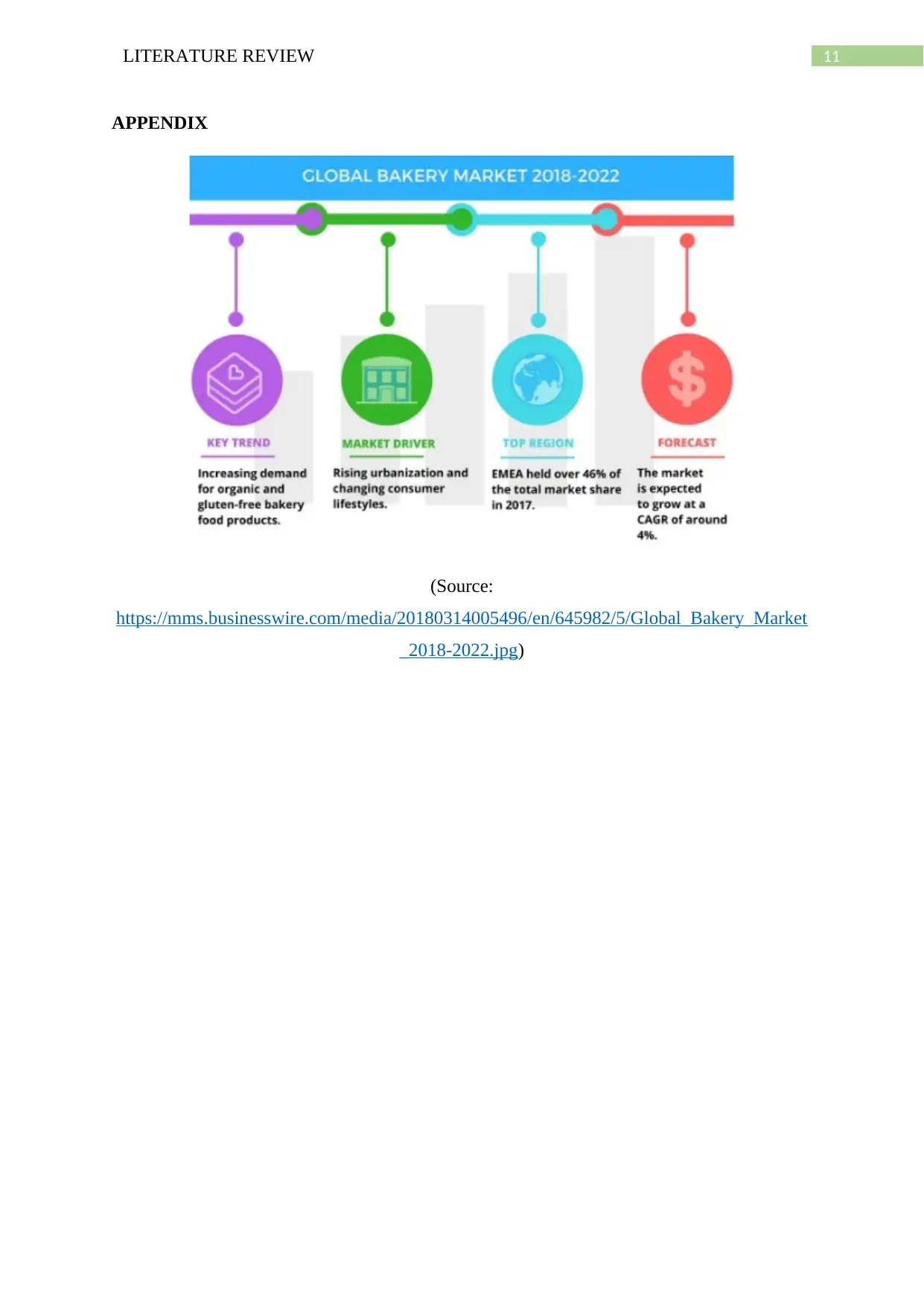
11LITERATURE REVIEW
APPENDIX
(Source:
https://mms.businesswire.com/media/20180314005496/en/645982/5/Global_Bakery_Market
_2018-2022.jpg)
APPENDIX
(Source:
https://mms.businesswire.com/media/20180314005496/en/645982/5/Global_Bakery_Market
_2018-2022.jpg)
1 out of 11
Related Documents
Your All-in-One AI-Powered Toolkit for Academic Success.
+13062052269
info@desklib.com
Available 24*7 on WhatsApp / Email
![[object Object]](/_next/static/media/star-bottom.7253800d.svg)
Unlock your academic potential
Copyright © 2020–2025 A2Z Services. All Rights Reserved. Developed and managed by ZUCOL.





